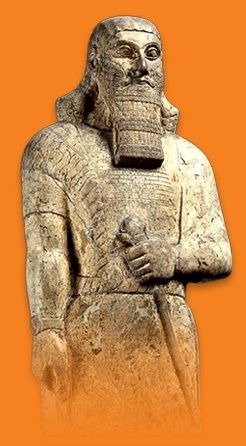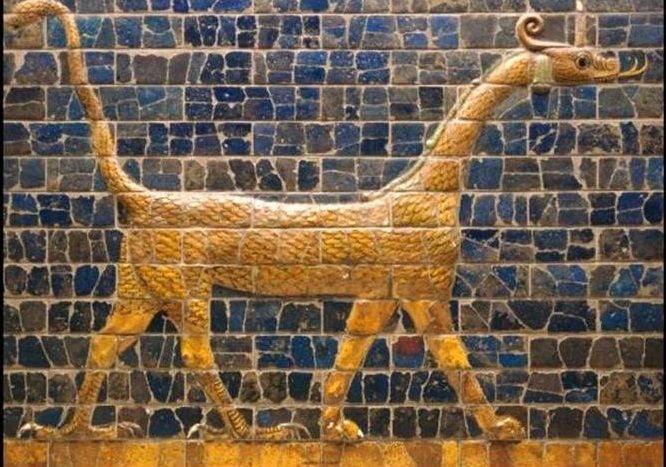The various cultures (Hittite, Assyrian, Babylonian and loads of others) collectively called Mesopotamia stretched over a period from about 3,500 BC to the conquest by Persia around 500 BC. About this big-time civilization (or if you prefer, these civilizations) most of us are woefully ignorant. The Royal Ontario Museum in Toronto has set out to bring it to life for us, and I was glad to have the chance to visit the exhibition last week. I'm not sure whether the artifacts collected for the show, some on loan from the British Museum, added a great deal to my understanding but they enhanced my apprecation.
Mesopotamia means "between the rivers" (in Greek, I think), and although the area extended farther in its heyday, it was generally centered on the Tigris and Euphrates, which the unhappy country of Iraq now occupies.
The items on view included pottery, most of which I confess having been indifferent to; jewelry -- it's amazing how similar it remains from era to era, the only significant difference being that it used to adorn men as well as women; and above all, sculpture.
The Mesopotamian cultures, especially the late Babylonian one, had a remarkable flair for cutting rock and bricks to produce images of power, violence, fantasy, and magic. Some of those at the British Museum are so massive that it would not have been feasible to bring them to Toronto, but the ones displayed in the ROM exhibition are as bold as you could ask for.
Among other things, they show warfare of times well before what we usually think of as the ancient world. The technology has changed drastically, but in essence what they picture is -- alas -- not unlike what you can see today in movies and the TV news.
One of the sculptors' artistic devices was to show scenes from a battle in successive images. (Medieval Italian painters often used a similar technique, showing important episodes in the life of a saint in the same picture.) The exhibition designer cleverly had someone make animations of these scenes, realistically colored, so you could follow the story better. There was also a large-screen digital animation taking us on an aerial and ground tour of Babylon with its ziggurat terraced palace and the famous Ishtar Gate.
One of the sculptors' artistic devices was to show scenes from a battle in successive images. (Medieval Italian painters often used a similar technique, showing important episodes in the life of a saint in the same picture.) The exhibition designer cleverly had someone make animations of these scenes, realistically colored, so you could follow the story better. There was also a large-screen digital animation taking us on an aerial and ground tour of Babylon with its ziggurat terraced palace and the famous Ishtar Gate.
The ROM is a hodge-podge of art, paleontology, gems and minerals, and more. Without the time or energy to see all the museum's contents, I decided to check out the classical galleries. The Roman section wasn't up to much, but the Greek collection was surprisingly comprehensive. Not quite up to the standard of the Met in New York or the British Museum, let alone the Archaeological Museum in Athens, but your attention is amply (or amphorically) rewarded. It's hard to believe so many splendid painted vases from ancient Greece have survived. And amazing to consider that what remains is surely only a small fraction of what was created.
But I was also dissatisfied with some aspects of the ROM. I won't go into the architectural vandalism represented by the new, edgy, cool modern addition that literally cuts into the Renaissance revival facade of the old building. Blockbuster-exhibition museums, or "destinations" in the language of tourism marketers, have lost the plot. They don't know where to draw a line that needs to be drawn if they are to be more than entertainment venues.
Their biggest sin is giving the viewer too much information. Too much text painted on the walls. Videos with sound tracks of talking heads explaining stuff, interspersed with the exhibits. Museums should be -- used to be -- places to go and look at things in a contemplative atmosphere. They've been turned into classrooms without seats.
But a museum can't, and ought not to try to, make you an expert on what you're seeing. It should be stimulating but not overstimulating. Some brief informative notes are helpful, but that's enough.
These shows like "Mesopotamia" tend to take the mystery out of the artifacts, leaving little room to connect imaginatively with them. We owe the forces of nature, craftspeople, and artists the respect to let them speak for themselves.





2 comments:
Welcome back. I was curious where you headed off to this time, you usually mention it beforehand.
If I was to take a vacation in mid-August, it wouldn't be Toronto, but in the same geographical area. Western NY, it's beautiful country and I have relatives there. It's always a kick for me to hear them complain about the heat (mid 80's at most) while I'm not even sweating.
So how is Homer? I thought about him when I stumbled upon this site.
Now unfortunately for a bit of a 'downer': In the latest TV ratings 'sweep' a surprising #1 happened: Univision Bests the Big Four in July Sweeps Ratings Contest.
The channel you skip past because it's in Spanish.
That would be like a French language channel winning #1 in Canada.
YIH,
The timing of the trip was to accommodate my and my wife's work schedules. But the weather was great -- sunny a lot of the time or partly cloudy, a few sprinkles but no rain, warm but not very hot.
Toronto was only for three days, then to Niagara Falls and back.
Homer is a madman, like all healthy kittens. Running, jumping, knocking stuff over. He also has a strange habit of licking earlobes. He's so cute it's impossible to be annoyed with him for long.
Post a Comment